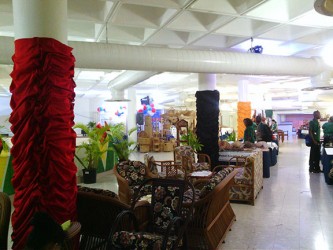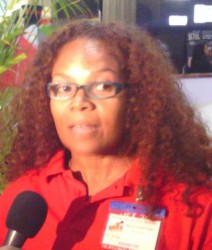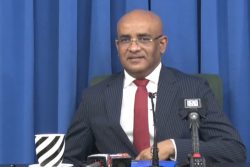At a time when the Caribbean’s fashion and creative industries are jousting for position to present their products to what has become a multi-billion dollar international market, Guyanese fashion designer Carol Fraser wants Guyana to focus more attention and investment on the quality of trade fairs and exhibitions by placing a greater measure of human and material resources at the disposal of such events.
Fraser raised this issue with the Stabroek Business just days after returning from the high-profile Barbados Manufacturers Exhibition, BMEX 2015, where a number of Guyanese creative and craftspeople displayed and marketed their goods alongside counterparts from elsewhere in the Caribbean and in the United States.
Fraser’s perspective on international trade fairs derives from what is now her considerable experience in attending these events. She believes that marketing success can well begin with the events that you attend and the opportunities that those events afford you to display your goods and engage potential buyers.

Earlier this week she told this newspaper that the time had come to adjust our understanding of the role trade fairs and other events play in attracting the market. They are not, she says, events that serve simply to show-off talent. They can be critical marketing opportunities events that could have major commercial implications.
Accordingly, the well-known local craftswoman who trades under the name Magic Hands, believes that at the organizational level Guyana can learn a great deal from Barbados and specifically from the BMEX event. Currently in its 34th year, the event seeks to provide an international platform primarily for the showcasing of Barbados’ creative goods. Guyana’s presence at this year’s May 18-22 event at the Lloyd Erskine Sandiford Centre provided more than 20 Guyanese with the opportunity to parade their goods on a stage that goes beyond the limited local confines.
This is the first time that Fraser has participated in BMEX and the exposure provided her with the opportunity to pay close attention to the logistical arrangements associated with the planning and execution of such events. What particularly caught her eye, she says, were the high delivery of standards associated as much with the fundamental exercise of marketing the event as with mundane considerations like event information, security, housekeeping and quality of staff. “On the whole they created an excellent environment for the marketing of creative products,” Fraser said.

Fraser believes that the high level of interaction between prospective buyers and sellers would have created enhanced opportunities trading opportunities for the Guyanese contingent in Barbados. Guyana, she said, was particularly well-represented in the areas of craft, leather, crochet, natural fibres and furniture.
Exposure to BMEX, Fraser says, has caused her to focus on how much more Guyana can do to develop the skills and capacity necessary for marketing the country and what it has to offer through trade fairs and exhibitions. While GuyExpo has long been considered to possess the potential to help place local goods on the international platform, the event has faced criticism associated chiefly with issues of crowd management, loud music and striking a balance between displays by local producers and overseas manufacturers seeking to capture the Guyana market. Fraser believes that a point has long been reached where the planning and execution of events like GuyExpo require skills that go beyond simply organizing the event. She believes that there should be clarity on expectations.
There have been occasions when local participation in international trade fairs have ended on a less than high note, Fraser told Stabroek Business that this time around it was different. She credits the Barbados experience largely with the inputs of the Go-Invest, which she said not only undertook the shipping of participants’ goods to Barbados but also played a role in facilitating hospitality for Guyanese participants in the event whilst in Barbados, the preparation of display booths and the supply of Guyana t-shirts that were worn during the event.
Fraser says that the Guyana contingent was particularly pleased to have been asked to demonstrate the creation of some of their products for the benefit of attendees at the event including school children.
On the whole, Fraser, it is a matter of understanding the value of trade shows. She believes that a local secretariat should be permanently responsible for the staging of trade shows and such events should be exposed to specialized training that should include visits to events like BMEX. In this regard she believes that particular attention should be paid to skills that can help in “putting buyers and sellers together.” In this regard she believes that Guyanese participating in external events should benefit from advance marketing including advance promotion through brochures and other communication tools. It is, she says, a matter of being as well-prepared as possible for these events.









